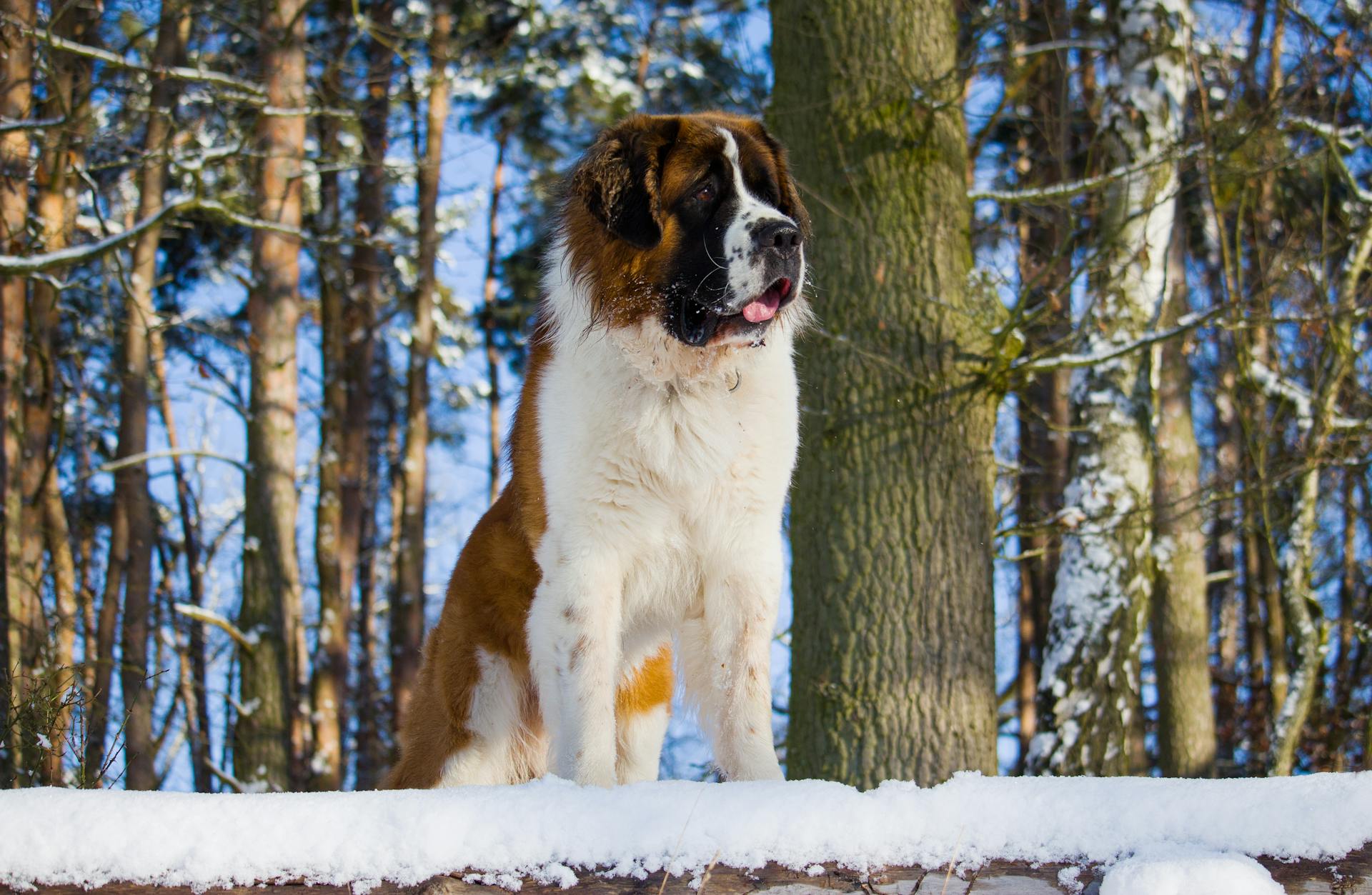
The Saint Bernard is a magnificent breed that's steeped in history and tradition. They originated in the Swiss Alps as rescue dogs, specifically bred to find and assist stranded travelers.
These gentle giants are known for their distinctive tri-colored coat, which can come in a variety of patterns and shades.
Saint Bernards are natural-born companions and thrive on human interaction, making them an excellent choice for families and individuals who want a loyal friend.
Care and Upkeep
Saint Bernard care and upkeep requires a significant investment of time, money, and space. The breed's large size demands ample space inside the house and a large vehicle for transportation.
Saints need regular exercise, but it should be moderate and not strenuous. An hour of interactive play or walking each day is ideal, but it's essential to avoid exercising them in warm weather.
Their coat care is relatively low maintenance, with weekly brushing and occasional bathing. However, daily brushing is recommended during the two shedding seasons, spring and fall.
Saints are prone to excessive drooling, which can be managed with a soft bed and a bib to catch saliva. They also require air-conditioned living quarters to prevent overheating, especially in warm weather.
With a lifespan of only 8-10 years, regular veterinary check-ups are crucial to prevent and detect potential health issues, such as gastric dilatation-volvulus (GDV) and osteosarcoma.
Temperament and Behavior
The Saint Bernard is a calm and easygoing breed, making them a great choice for people of all ages. They are a low-energy dog and a slow mover, which means they don't require a lot of exercise.
Saint Bernards learn quickly, but they tend to respond methodically, so be patient with them. They are very affectionate and demonstrative toward family and fairly friendly toward strangers.
They are generally good with other household pets, canine or feline, but they may not interact well with unfamiliar dogs. It's essential to socialize them properly to prevent any issues.
Playtime tends to be short in duration once they reach adulthood, so don't expect them to be high-energy playmates. They love the snow, however, and can be great companions for cold-weather activities.
Saint Bernards are not great watchdogs or protection dogs, but their sheer size and deep bark are enough to intimidate most intruders. They don't bark without reason, which means you'll know if something's amiss.
It's crucial to train a Saint Bernard when they're still a puppy, as they can grow to be quite large and difficult to manage. Obedience training from an early age is key, and positive reinforcement works wonders with this breed.
They are often referred to as 'nanny' dogs due to their kind and careful temperament, making them an excellent choice for families with young children. However, it's always recommended to supervise interactions between Saint Bernards and little ones.
Pros and Cons
Saint Bernards are a popular choice for families and hunters alike, but like any large breed, they have their pros and cons.
Their gentle nature makes them an excellent companion for children, as they are patient and even-tempered.
However, their size can be a challenge for some owners, requiring more space and exercise than smaller breeds.
Their short coats are easy to maintain, but they shed heavily, especially during shedding season.
On the other hand, their intelligence and trainability make them relatively easy to train, even for inexperienced owners.
Despite their large size, Saint Bernards are relatively low-maintenance when it comes to grooming, requiring only occasional nail trimming and ear cleaning.
Their strong instinct to follow a scent can make them excellent hunting companions, but it also means they can be easily distracted if not properly trained.
Expand your knowledge: Dogo Argentino Large
Health and Wellness
Saint Bernards are prone to certain health issues, so it's essential to be aware of them.
They typically live for around eight to 10 years, but their large size makes them susceptible to joint problems. Hip & Elbow Dysplasia can have a significant impact on their joints, leading to chronic arthritis and joint dysplasia in later years.
Bloat is another potential issue, with deep-chested dogs like Saint Bernards at a higher risk. Keep an eye out for panting, drooling, restlessness, and a tense, bloated abdomen, as prompt treatment is needed.
Ear problems are also common due to their pendulous ears, which can lead to ear infections. Regular ear cleaning and drying after bath time or swims can help prevent infections.
If you're buying from a breeder, look for parents who have undergone relevant health screening tests. You can also consider adopting from a rescue centre, which should provide information on any health and behaviour issues.
As your Saint Bernard matures, it's crucial not to over-exercise them, as this can exacerbate joint issues. Opt for off-lead exercise on grass or sand instead of repetitive jogging on pavement.
A unique perspective: St Bernard Dog Health Issues
Characteristics and Facts
Saint Bernards are natural athletes that need lots of exercise and playtime, so they're perfect for active families. They're intelligent and affectionate, but they can be messy, shedding a lot and leaving fur on your sofa.
You'll need to brush them at least three times a week to keep on top of all the dead hair, and you may also choose to have them professionally groomed every few months. Saint Bernards are not low-maintenance dogs, but with regular care, they'll be happy and healthy.
They're not suited for hot climates, but their warm and water-repellent coats are great for snowy and icy conditions. Saint Bernards are originally from Switzerland, where they're considered the national dog.
Here are some key facts about Saint Bernards:
Saint Bernards have a rich history, dating back to the 5th century, and were originally bred for "tolling", or luring game. They're natural pack animals and enjoy working together.
Frequently Asked Questions
Is Saint Bernard the biggest dog?
While Saint Bernards can be quite large, they are not typically considered the biggest dog breed. The heaviest recorded Saint Bernard, Benedictine, weighed 366 pounds, but the average weight for this breed is around 141-180 pounds.
Which is bigger mastiff or Saint Bernard?
Mastiffs are the larger of the two breeds. They tend to be bigger in size compared to St. Bernards.
Which is bigger Great Dane or St. Bernard?
The Great Dane and Saint Bernard are similar in size, with the Great Dane weighing slightly less but being slightly taller on average. However, both breeds are large and powerful, making them impressive companions.
Sources
- https://www.britannica.com/animal/Saint-Bernard-breed-of-dog
- https://www.readersdigest.ca/home-garden/pets/world-s-largest-dog-breeds/
- https://www.akc.org/dog-breeds/st-bernard/
- https://www.yourpurebredpuppy.com/reviews/saintbernards.html
- https://www.countryliving.com/uk/wildlife/dog-breeds/a42684030/saint-bernard-dog/
Featured Images: pexels.com


